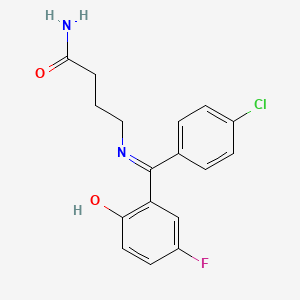

1. Gabrene
2. Sl 76002
1. 62666-20-0
2. Halogabide
3. Gabren
4. Gabrene
5. Progabidum [inn-latin]
6. Progabida [inn-spanish]
7. 4-(((4-chlorophenyl)(5-fluoro-2-hydroxyphenyl)methylene)amino)butanamide
8. Sl 76002
9. Progabide, (z)-
10. Sl-76002
11. Sl 76 002
12. 112e50torv
13. 4-[[(e)-(4-chlorophenyl)-(3-fluoro-6-oxocyclohexa-2,4-dien-1-ylidene)methyl]amino]butanamide
14. Butanamide, 4-(((4-chlorophenyl)(5-fluoro-2-hydroxyphenyl)methylene)amino)-
15. 38c836j57z
16. Progabida
17. Progabidum
18. Progabide [usan:ban:inn]
19. Progabide [usan:inn:ban]
20. Progabide (usan/inn)
21. Sl 76-002
22. Butanamide, 4-(((4-chlorophenyl)(5-fluoro-2-hydroxyphenyl)methylene)amino)-, (z)-
23. Butanamide, 4-[[(4-chlorophenyl)(5-fluoro-2-hydroxyphenyl)methylene]amino]-, (e)-
24. 104880-78-6
25. 90656-51-2
26. Gabren (tn)
27. Einecs 263-679-4
28. Brn 2339306
29. Unii-38c836j57z
30. 4-((alpha-(p-chlorophenyl)-5-fluorosalicylidene)amino)butyramide
31. 4-(alpha-(p-chlorophenyl)-5-fluoro-2-hydroxybenzylideneamino)butyramide
32. 4-[[(z)-(4-chlorophenyl)-(3-fluoro-6-oxocyclohexa-2,4-dien-1-ylidene)methyl]amino]butanamide
33. Progabide [inn]
34. Progabide [mi]
35. Progabide [usan]
36. Progabide [mart.]
37. Butyramide, 4-(alpha-(p-chlorophenyl)-5-fluoro-2-hydroxybenzylideneamino)-
38. Progabide [who-dd]
39. Unii-112e50torv
40. Schembl35328
41. Schembl35329
42. Schembl340485
43. Schembl341677
44. Chembl287631
45. Chembl4796538
46. Dtxsid00878140
47. Chebi:135422
48. Hy-a0173
49. Zinc13519914
50. Zinc18153101
51. Akos016013958
52. Db00837
53. Cs-0017513
54. Ft-0674038
55. D05621
56. 666p200
57. A833914
58. Q426524
59. 4-((.alpha.-(p-chlorophenyl)-5-fluorosalicylidene)amino)butyramide
60. 4-[(4-chlorophenyl) (5-fluoro-2-hydroxy-phenyl)-methylene]amino Butanamide
61. 4-[[(4-chlorophenyl)-(5-fluoro-2-hydroxyphenyl)methylidene]amino]butanamide
62. 4-[[(4-chlorophenyl)( 5-fluoro-2-hydroxyphenyl)-methylene]amino ]butanamide
63. 4-[[(z)-(4-chlorophenyl)-(3-fluoro-6-oxo-cyclohexa-2,4-dien-1-ylidene)methyl]amino]butanamide;progabide
64. 4-{[(4-chlorophenyl)[(1e)-3-fluoro-6-oxocyclohexa-2,4-dien-1-ylidene]methyl]amino}butanamide
| Molecular Weight | 334.8 g/mol |
|---|---|
| Molecular Formula | C17H16ClFN2O2 |
| XLogP3 | 3 |
| Hydrogen Bond Donor Count | 2 |
| Hydrogen Bond Acceptor Count | 4 |
| Rotatable Bond Count | 6 |
| Exact Mass | 334.0884336 g/mol |
| Monoisotopic Mass | 334.0884336 g/mol |
| Topological Polar Surface Area | 75.7 Ų |
| Heavy Atom Count | 23 |
| Formal Charge | 0 |
| Complexity | 425 |
| Isotope Atom Count | 0 |
| Defined Atom Stereocenter Count | 0 |
| Undefined Atom Stereocenter Count | 0 |
| Defined Bond Stereocenter Count | 0 |
| Undefined Bond Stereocenter Count | 0 |
| Covalently Bonded Unit Count | 1 |
Indicated for the treatment of epilepsy.
Progabide, a fatty acid derivative, is a GABA receptor agonist used to treat the symptoms of epilepsy.
Anticonvulsants
Drugs used to prevent SEIZURES or reduce their severity. (See all compounds classified as Anticonvulsants.)
Antidepressive Agents
Mood-stimulating drugs used primarily in the treatment of affective disorders and related conditions. Several MONOAMINE OXIDASE INHIBITORS are useful as antidepressants apparently as a long-term consequence of their modulation of catecholamine levels. The tricyclic compounds useful as antidepressive agents (ANTIDEPRESSIVE AGENTS, TRICYCLIC) also appear to act through brain catecholamine systems. A third group (ANTIDEPRESSIVE AGENTS, SECOND-GENERATION) is a diverse group of drugs including some that act specifically on serotonergic systems. (See all compounds classified as Antidepressive Agents.)
GABA Agonists
Endogenous compounds and drugs that bind to and activate GAMMA-AMINOBUTYRIC ACID receptors (RECEPTORS, GABA). (See all compounds classified as GABA Agonists.)
Antiparkinson Agents
Agents used in the treatment of Parkinson's disease. The most commonly used drugs act on the dopaminergic system in the striatum and basal ganglia or are centrally acting muscarinic antagonists. (See all compounds classified as Antiparkinson Agents.)
N - Nervous system
N03 - Antiepileptics
N03A - Antiepileptics
N03AG - Fatty acid derivatives
N03AG05 - Progabide
Absorption
Well absorbed with a bioavailability of 60%
Hepatic
4 hours
Progabide binds to both GABAA and GABAB receptors located on the terminals of primary afferent fibers. Binding to GABAA results in an increased affinity of the GABA receptor for the amino acid, an augmented flux of chloride ions across the terminal membrane, and an increase in the amount of presynaptic inhibition. Activation of the GABAB receptors retards the influx of calcium ions into the terminals, thereby reducing the evoked release of excitatory amino acids and possibly other transmitters.